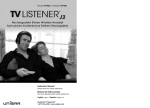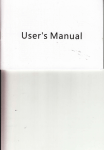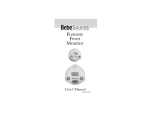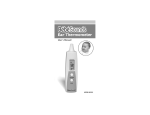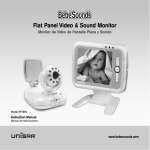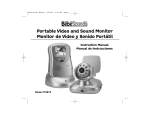Download Unisar TV920 Instruction manual
Transcript
Model #TV920 | Modelo #TV920 Rechargeable Stereo Wireless Headset Auriculares Inalámbricos Estéreo Recargables Instruction Manual Please save for future reference. Manual de Instrucciones Por favor guarde para futura referencia. English: page 2 / Español: página 18 Questions? Preguntas? 1-877-736-6760 / www.unisar.com www.ActiveForever.com Warning Please read all safety and operating instructions carefully and completely before using this product. Thank you for purchasing the Unisar® TV Listener® J3. This infrared wireless stereo headset system will enable you to listen to your television, stereo, computer, or any other audio device at a volume that is comfortable for you without disturbing others in the room. It is intended for use if you have difficulty hearing, if you simply want to watch television at a different volume than others in the room, or if you want to watch television while someone else is sleeping. 1. For your well-being, medical experts advise against playing any audio device at a high volume for continuous and extended play. If you hear a ringing in your ears, reduce the volume immediately or discontinue use. Please review the installation choices that are in this manual and determine which features your television or audio device has before setting up your TV Listener J3. Please save this manual for future reference. 2. To reduce the risk of fire or electrical shock, do not expose this product to water or moisture. If you have any questions, please contact our Customer Service Department at 1-877-736-6760 Mon-Fri from 9:00AM-5:00PM Eastern Time, or e-mail us at [email protected]. 3. To prevent overheating, keep this product away from heat sources such as radiators, stoves, fireplaces, or direct sunlight. 4. Use only the AC adapter provided with the transmitter. Use of any other adapter may damage the unit and void the warranty. Table of Contents 5. Plug the AC adapter into standard household current only (120 volt AC outlet). How It Works / page 4 6. Avoid damage to the adapter cords. Route cords so that they are not likely to be walked on or pinched by items placed upon or against them. Setting Up the System / page 4 Operating the System / page 10 7. Use only AAA rechargeable batteries with the headset. Tips for Using Your TV Listener J3 / page 12 8. Do NOT use alkaline batteries or you will severly damage the unit. Care and Cleaning / page 12 9. Dispose of batteries properly and safely. Troubleshooting / page 13 10. Unplug the AC adapter and remove batteries during long periods of non-use. Technical Specifications / page 15 11. Do NOT disassemble. Limited Product Warranty / page 15 Also Available / page 16 En Español / página 18 Infrared Light Rays Headset Transmitter {2} {3} How It Works The TV Listener J3 works just like your remote control, sending an invisible infrared signal from your television or any other audio device to the deluxe stereo headset. Unlike radio frequency devices, infrared is not subject to interference from cordless phones, wireless networks, microwaves, etc. You adjust the volume on the wireless, lightweight headset to suit your personal needs. Multiple headsets can be used with one transmitter. 6.3mm stereo headphone adapter AC adapter Microphone adapter Setting Up the System RCA 3.5mm stereo adapter Charge the batteries in the headset for 16 hours prior to first use. TV Listener J3 Components Check that you have all the following components before installation. RCA 3.5mm mono adapter 2 AAA rechargeable batteries Transmitter (connects to your TV or other audio device) Power Switch Installation of the Transmitter The following are the five different ways to connect the TV Listener J3. Your installation will depend on the type of equipment you have. AC Adapter Jack Charging Adapter Infrared Rays Headphone Adapter 1. STEREO INSTALLATION – for equipment with two audio output jacks (stereo televisions, DVD players, cable boxes). Refer to Pg. 6. 2. MONO INSTALLATION – for equipment with only one audio output jack (mono televisions, DVD players, cable boxes). Refer to Pg. 6. 3. SMALL HEADPHONE JACK INSTALLATION – for equipment with a small headphone jack (most CD players, portable stereos, MP3 players). Refer to Pg. 7. Wireless Headset 4. LARGE HEADPHONE JACK INSTALLATION – for equipment with a large headphone jack (some home stereo systems). Refer to Pg. 8. 5. MICROPHONE INSTALLATION – for equipment that does not have any audio output jacks. Refer to Pg. 8. Battery Compartments Power Indicator Light Infrared Sensors Power Switch Volume Control Infrared Sensors {4} Charging Jack Charging Indicator Light {5} Follow these instructions if your equipment only has one audio output jack (mono televisions, DVD players, cable boxes). STEREO INSTALLATION Fig. 1 1. Connect the audio cord on the back of the transmitter (A) to the RCA 3.5mm mono adapter (E). white - LEFT 2. Plug the other end of the adapter into the audio output jack on your equipment. If you are connecting to your television, use the audio jack located on the back. Do NOT use the audio jacks on the front as these are audio input jacks. Be sure to plug the adapter into the audio output and not the video output. red - RIGHT If you are connecting to a device that is connected to your television (DVD player, VCR, cable box, home theater system), this device must stay on when using the TV Listener. The VCR must also be set to the same channel as the television. Follow these instructions if your equipment has two audio output jacks (stereo televisions, DVD players, cable boxes). 1. Connect the audio cord on the back of the transmitter (A) to the RCA 3.5mm stereo adapter (D). 2. Plug the red end of the adapter into the right audio output jack and the white end into the left audio output jack on your equipment. 3. Plug the AC adapter (C) into the jack marked “DC IN” on the back of the transmitter and plug the adapter into an electrical outlet. For long periods of non-use, we suggest unplugging the AC adapter. SMALL HEADPHONE JACK INSTALLATION Fig. 3 If you are connecting to your television, use the audio jacks located on the back. Do NOT use the audio jacks on the front as these are audio input jacks. Be sure to plug the adapter into the audio output and not the video output. If you are connecting to a device that is connected to your television (DVD player, VCR, cable box, home theater system), this device must stay on when using the TV Listener. The VCR must also be set to the same channel as the television. 3. Plug the AC adapter (C) into the jack marked “DC IN ” on the back of the transmitter and plug the adapter into an electrical outlet. For long periods of non-use, we suggest unplugging the AC adapter. MONO INSTALLATION Fig. 2 Follow these instructions if your equipment has a small headphone jack (CD players, portable stereos, computers, MP3 players). 1. Connect the audio cord on the back of the transmitter (A) directly into the headphone jack on your equipment. 2. Plug the AC adapter (C) into the jack marked “DC IN” on the back of the transmitter and plug the adapter into an electrical outlet. For long periods of non-use, we suggest unplugging the AC adapter. {6} {7} LARGE HEADPHONE JACK INSTALLATION Fig. 4 4. Plug the AC adapter (C) into the jack marked “DC IN” on the back of the transmitter and plug the adapter into an electrical outlet. For long periods of non-use, we suggest unplugging the AC adapter. Headset Battery Installation IMPORTANT: Charge the batteries for 16 hours prior to first use. You must only use rechargeable batteries (included). Do NOT use alkaline batteries or you will severely damage the unit. Follow these instructions if your equipment has a large headphone jack (home stereo systems). 1. Connect the audio cord on the back of the transmitter (A) to the 6.3mm stereo headphone adapter (F). 2. Plug the other end of the adapter into the headphone jack on your audio device. 3. Plug the AC adapter (C) into the jack marked “DC IN” on the back of the transmitter and plug the adapter into an electrical outlet. For long periods of non-use, we suggest unplugging the AC adapter. MICROPHONE INSTALLATION The wireless headset (B) requires two rechargeable AAA batteries (included). To access the battery compartment on each ear piece, take off the ear pads (refer to Fig. 6). To remove the ear pads, gently pull them off the headset. Insert one rechargeable AAA battery in each side matching positive (+) to positive (+) and negative (-) to negative (-). Do NOT use alkaline batteries. To replace the ear pads, snap them back on by lining up the prongs with the corresponding openings on the headset. Charge the batteries for 16 hours prior to first use. Be sure the headset is turned off and the transmitter is plugged in to an electrical outlet and turned on. Plug the charging adapter from the back of the transmitter into the jack marked “CHG” on the right earpiece ( ) of the headset (refer to Fig. 7). The green charging indicator light on the headset will illuminate. On a full charge, the battery life is approximately 15 hours. Recharge when the volume begins to weaken. Do not charge for more than 24 consecutive hours as it will shorten the life of the batteries. For long periods of non-use we suggest removing the batteries. Fig. 5 The batteries need to be replaced when they last much less than the expected time (approximately 15 hours) after proper charging. Be sure to replace ONLY with rechargeable AAA batteries. Do NOT mix alkaline and rechargeable batteries. Fig. 6 Ear Pad AAA Battery Follow these instructions if your equipment does not have any audio output jacks. 1. Connect the audio cord on the back of the transmitter (A) to the microphone adapter (G). 2. Affix the microphone mounting piece directly over the speaker on your television or audio device by exposing the adhesive strip. Insert the microphone into the mounting piece. 3. You will have to set your audio device to a very low volume. You can also change the volume on the headset by adjusting the placement of the microphone. {8} {9} 5. Adjust the volume to a comfortable listening level using the volume control dial. If the headset is out of the range of the transmitter or the infrared sensors in the headset are being blocked, no sound will come through the headset. Fig. 7 6. We recommend turning the transmitter and headset off after each use except when charging the headset when the headset should be off and the transmitter should be on. Regardless of what type of equipment you have and which installation instructions you follow, when you connect the transmitter the sound will be heard either (1) through your headset and television speakers, or (2) just through your headset. The following instructions will apply to all five types of installation. Operating the System 1. Place the transmitter at or close to your eye level when you are sitting. There should be nothing obstructing the transmission of the infrared light rays from the transmitter to the receiver in your headset (refer to Fig. 8). The transmitter must be within 33 feet (10 meters) of the headset for the system to work properly. NOTE: Avoid exposure to direct sunlight. Direct sunlight may interfere with the reception. It is also subject to interference from treadmills. Fig. 8 Infrared Light Rays 1. The sound from your television is heard from your headset and your television speakers. If you want the sound to be heard only from the headset, you will need to mute the television sound. If you simply turn the volume down all the way, you may reduce the signal going to the television audio output jacks which will affect the sound coming through your headset. To mute the television sound, press Mute on your remote control. Or, if your TV has a speaker switch on the back panel, set this switch to “OFF”. If pressing “Mute” on your remote also turns off the sound from your headset, your TV may have speaker options that you can access with your television's remote control. Please refer to your television instruction manual to locate this control and set it to “OFF”. 2. The sound from your television will only be heard through your headset and will not be heard from the television speakers. If you want the sound to be heard from the headset and the television speakers, connect the transmitter to your DVD player, VCR, or cable box or use the microphone adapter (refer to Pg. 8). NOTE: If you hear static or a radio signal from your headset, it may be due to the electric current to the transmitter. Unplug the AC adapter from the electrical outlet and plug it into a surge protector. Then plug the surge protector into the electrical outlet. 2. Turn the transmitter on by sliding the power switch to the “ON” position. Four red lights on the front of the transmitter will illuminate. 3. Turn the headset on by sliding the power switch to the “ON” position on the right earpiece ( ). The red power indicator light will illuminate. To prevent possible damage to your ears, be sure to lower the volume on the headset before putting it on. If you are using your TV Listener J3 with an LCD or plasma television and are experiencing static, connect the transmitter to your cable box instead of your television. Move the transmitter as far from your television as possible while making sure it is still in the line of sight of the headset. There is no limit to the number of headsets that can be used with a single transmitter. Please call us at 1-800-430-0222 to find out where you can purchase additional headsets. 4. Put the headset on making sure the right earpiece ( ) goes over your right ear and the left earpiece ( ) goes over your left ear. Caution: To prevent possible damage to your ears, be sure to lower the volume on the headset before putting it on. {10} {11} Tips for Using Your TV Listener J3 Troubleshooting • If you are using your TV Listener J3 with an LCD or plasma television and are experiencing static, connect the transmitter to your cable box instead of your television. Follow the instructions for Stereo Installation on Pg. 6. Also, move the transmitter so that it is not directly in front of your television. Move the transmitter as far from the television as possible while making sure it is still in the line of sight of the headset. If you believe your TV Listener J3 is not operating properly, please refer to the Troubleshooting Guide below. Improper installation of the transmitter is the leading cause of malfunctions. If you are unable to solve the problem after checking the Troubleshooting Guide, please follow the instructions for microphone installation (refer to Pg. 8). If you can hear your audio device from the headset using the microphone, the problem may be due to improper installation or issues with your television or audio device. If you can not hear anything from the headset when using the microphone, please contact our Customer Service Department at 1-877-736-6760 Mon-Fri from 9:00AM-5:00PM Eastern Time, or e-mail us at [email protected]. • If you hear static or a radio signal from your headset, it may be due to the electric current to the transmitter. Unplug the AC adapter from the electrical outlet and plug it into a surge protector. Then plug the surge protector into the electrical outlet. • When connecting to your television or other audio equipment, be sure to use the audio OUTPUT jacks. If you are connecting to your television, these jacks are located on the back of the television. Do NOT use the audio jacks on the front as these are audio input jacks. • When charging your headset, make sure the transmitter is turned on and the headset is turned off. PROBLEM POSSIBLE CAUSE SOLUTION Four red lights on transmitter do not illuminate. AC adapter is not connected or electrical outlet is out of order. Check connection or change to another electrical outlet. Transmitter is not turned on. Make sure power switch is set to “ON” position. Power indicator light on headset does not illuminate. Batteries in headset are low or improperly installed. Check or charge batteries. Use only AAA rechargeable batteries. Do NOT use alkaline batteries. No sound from headset. Transmitter and/or headset are not on. Make sure both units are on. Batteries in headset are low or improperly installed. Check or charge batteries. Use only AAA rechargeable batteries. Do NOT use alkaline batteries. Headset is not in line of sight of transmitter. Make sure nothing is obstructing the transmission of the infrared light rays from transmitter to headset. No audio output from audio device. Check sound on your audio device. Transmitter is not properly plugged into audio device. Check connections. Make sure adapter is plugged into the audio output jack (not input). Headset and transmitter are too far apart. Bring them closer together. Maximum range is 33 feet (10 meters). • Only use rechargeable batteries. Do NOT use alkaline batteries or you will severely damage the hedset. • If your headset is not working, check the batteries first. Make sure the batteries are charged and properly installed. Also, be sure the transmitter is turned on. Care & Cleaning Disconnect the transmitter and remove all batteries from the headset before cleaning. Clean the exterior of the units with a soft, dry or slightly damp cloth. Do NOT spray with cleaning products or solvents. Do NOT submerge in water or any other liquid. {12} {13} Sound from headset is low or poor. There is static coming from headset. There is a radio signal coming from headset. There is sound coming from only one side of the headset. {14} Volume on headset is too low. Increase volume level. Headset and transmitter are too far apart. Bring them closer together. Maximum range is 33 feet (10 meters). Headset is not in line of sight of transmitter. Make sure nothing is obstructing the transmission of the infrared light rays from transmitter to headset. Transmitter is not placed properly. Place transmitter at or close to your eye level when you are sitting. Infrared sensors in headset are obstructed. Make sure infrared sensors are not being blocked by clothing, hair, hands, etc. Interference from sunlight. Position unit away from direct sunlight. Batteries in headset are low. Check or charge batteries. Use only AAA rechargeable batteries. Do NOT use alkaline batteries. Electric current to transmitter is causing static. Plug AC adapter into surge protector and then plug surge protector into electrical outlet. LCD or plasma television is causing static. Plug the transmitter into your cable box instead of your television. Move transmitter so it is not directly in front of the TV. Headset is not in line of sight of transmitter. Make sure there isn't anything obstructing the transmission of the infrared light rays from transmitter to headset. Electric current to transmitter is causing the radio signal. Audio cord is not properly plugged into audio device. Plug AC adapter into surge protector and then plug surge protector into electrical outlet. Check connections. Make sure you have not connected the stereo adapter into a mono output. Technical Specifications Power Supply 12V, 200mA AC adapter for transmitter 2 rechargeable AAA batteries for headset Maximum Operating Distance 33 feet (10 meters) Battery Life Over 15 hours Transmission Mode Infrared 850 nanometers Frequency Modulation 2.3 MHz (left); 2.8 MHz (right) Frequency Response 40 Hz–12000 Hz Distortion 1% THD Signal to Noise Ratio 40 dB RoHS Limited Product Warranty Unisar Inc., the distributor of the TV Listener® J3 (Model #TV920), warrants to the original owner of this product that this product is free from defects in materials and workmanship for a period of six (6) months from the date of the original purchase. If this product fails to function properly when used as directed under normal conditions within the six-month period, Unisar Inc. will either repair or replace the product, at its option, free of charge, when it is returned in its original packaging, postage prepaid, with proof of purchase. Unisar Inc. will bear the cost of repairing or replacing the product and shipping it back to you within the United States. Repair or replacement of the defective product is subject to verification of the malfunction or defect when delivered to: Unisar® Service Center 51-02 21 Street, Floor 7 Long Island City, NY 11101 NOTE: The warrantor expressly disclaims liability for incidental, consequential, or special damages of any nature. This warranty does not cover: 1) A defect that has been caused by repair or modification by any person other than a Unisar technician; 2) A defect caused by negligence, accident, or misuse of the product; 3) A defect caused by incorrect installation of and/or defective batteries; 4) Battery life; 5) A defect caused by the use of any adapter not provided by the warrantor; or 6) Damage resulting from improper operation. LEGAL RIGHTS VARY FROM STATE TO STATE. NOTE: This warranty is valid only for products sold in the United States. If you have purchased this product outside of the United States, please see your local retailer or distributor for service. If you have any questions, please contact our Customer Service Department at 1-877-736-6760 Mon-Fri from 9:00AM-5:00PM Eastern Time, or e-mail us at [email protected]. www.ActiveForever.com {15}








